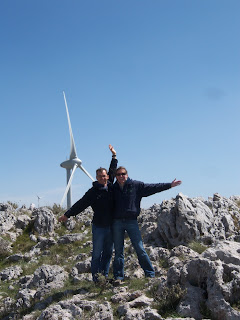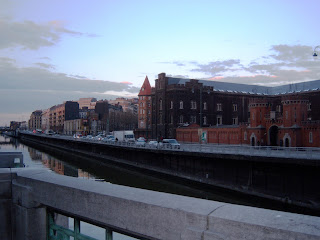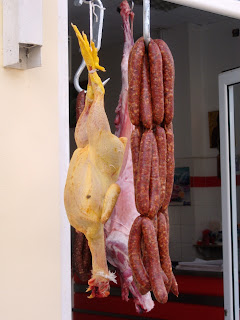A week and a half ago, one of our professors took us on a field trip to a wind farm near Tripoli (central Peloponnese). The featured wind farm was comprised of five 2-megawatt Enercon wind generators on one ridge top; there is also a similarly sized, second wind farm (with different owners) on a parallel adjacent ridge.
.
This wasn’t the first wind farm we’ve visited – in fact, it was my third since starting the master’s program – but what made this visit special: we climbed. The Enercon maintenance staff provided full climbing gear for five of us (at a time) to climb, with guides in front and behind to help ensure safety. The tower was 65m (213 feet) tall, so it was no cakewalk… but it was doable, and all twelve of us "windies" (plus two visitors) made the climb. The entire climb took place on the inside of the tower, so we saw very little, except the very tall ladder and climbing compatriots above and below us, throughout our ascent.
This wasn’t the first wind farm we’ve visited – in fact, it was my third since starting the master’s program – but what made this visit special: we climbed. The Enercon maintenance staff provided full climbing gear for five of us (at a time) to climb, with guides in front and behind to help ensure safety. The tower was 65m (213 feet) tall, so it was no cakewalk… but it was doable, and all twelve of us "windies" (plus two visitors) made the climb. The entire climb took place on the inside of the tower, so we saw very little, except the very tall ladder and climbing compatriots above and below us, throughout our ascent.
.
After what seemed like 15-20 minutes of climbing (although it must have been much less than this -- how long can it possibly take to climb 200'?), we finally reached the nacelle (i.e. the big chamber directly behind the blades). After a tour of the generator stator/rotor anatomy and the blade-pitching motor controls, we were allowed to enter through a small crawlspace into the “hub” (i.e. nose cone) to inspect the locations where the blades attach to the drive train. Lastly, the nacelle’s top hatch was opened, so we could stick our heads out of the top to check out the view – absolutely incredible! Some folks don’t like heights, but I’m of the opposite persuasion: I LOVE heights! The sights… the crisp, windy air… oh, and the dizzying rush – wow, really nice!
After what seemed like 15-20 minutes of climbing (although it must have been much less than this -- how long can it possibly take to climb 200'?), we finally reached the nacelle (i.e. the big chamber directly behind the blades). After a tour of the generator stator/rotor anatomy and the blade-pitching motor controls, we were allowed to enter through a small crawlspace into the “hub” (i.e. nose cone) to inspect the locations where the blades attach to the drive train. Lastly, the nacelle’s top hatch was opened, so we could stick our heads out of the top to check out the view – absolutely incredible! Some folks don’t like heights, but I’m of the opposite persuasion: I LOVE heights! The sights… the crisp, windy air… oh, and the dizzying rush – wow, really nice!
.
Here are some pics from the journey:
Here are some pics from the journey:
.

Pit stop at the Corinth Canal, which cuts through the Isthmus of Corinth and connects the Ionian and Aegean Seas
.
.











































